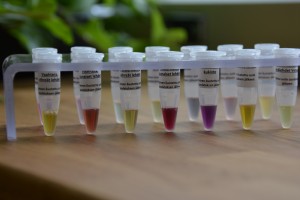 Plants produce hundreds of different polyphenol structures for their own protection. Some structures are chemically simple while others still await their full structures to be elucidated via an array of chemical methods. For the known polyphenol structures the protective effect may be yielded by several types of activities and the PolyphenOx project mainly focuses on one of the least studied activity type of polyphenols, i.e. their ease of oxidation. At the same time we record the protein precipitation capacity and estimate the antioxidant activity of the plant species studied.
Plants produce hundreds of different polyphenol structures for their own protection. Some structures are chemically simple while others still await their full structures to be elucidated via an array of chemical methods. For the known polyphenol structures the protective effect may be yielded by several types of activities and the PolyphenOx project mainly focuses on one of the least studied activity type of polyphenols, i.e. their ease of oxidation. At the same time we record the protein precipitation capacity and estimate the antioxidant activity of the plant species studied.
The main target of this project is to study the distribution of polyphenol-based pro-oxidant defenses – with special emphasis on ellagitannins – in the plant kingdom. This is achieved by accurate chemical measurements of hundreds or even thousands of plant species collected from five different continents. We try to cover the plant tree of life as widely as practically possible to make further conclusions of the evolution of plant pro-oxidant defenses.
In addition to bioactivities, every species is examined by UPLC-DAD-MS/MS for the concentrations of the following polyphenol groups: (1) ellagitannins, (2) gallic acid derivatives, (3) procyanidins, (4) prodelphinidins, (5) quinic acid derivatives, (6) kaempferol derivatives, (7) quercetin derivatives, and (8) myricetin derivatives. In addition, every species is qualitatively checked for the identity of its main polyphenol structures by careful inspection of UV and MS spectra, and information acquired by compounds’ retention time.
This project will answer the following major hypotheses/questions:
1. How are the pro-oxidant polyphenols (and pro-oxidant activity) distributed in the plant kingdom and what polyphenol types are the most pro-oxidant ones? Is the distribution of the active/inactive structures evolutionarily conserved among plant species, whereby the most closely related plant species show similar compounds and activities?
2. Do we see evidence for the latitudinal herbivory defence hypothesis in the global distribution of the pro-oxidant activity (and pro-oxidant polyphenols), i.e. are the tropical plants better equipped against herbivores than the plants growing in the more temperate hemispheres? If the pro-oxidant activity shows trends into either direction (tropics vs. poles), are there any specific pro-oxidant polyphenols or polyphenol groups governing this trend?
3. How are the pro-oxidant defenses (pro-oxidant polyphenol molecules and pro-oxidant activity) evolved in ecologically relevant families and genus like Quercus, Onagraceae and Eucalypts? Can we map these chemical traits onto existing phylogenies to reveal the evolution of the pro-oxidant polyphenols in these families and genus, and the degree to which these evolutionary trends constrain current day faunal communities?
This project is funded by the Academy of Finland (2012-2016) and lead by prof. Juha-Pekka Salminen. The project has one post doc (Dr. Jeff Ahern), one project researcher (MSc Anne Koivuniemi) and gives support to one PhD student (MSc Jorma Kim) and several undergraduates (Atte Tuominen, Hanna-Mari Salmia, Milla Leppä, Jussi Suvanto, Marianne Oraviita).
Further links:
https://naturalchemistry.utu.fi/hyonteiset-vaikuttavat-kasvien-evoluutioon-jo-muutamassa-vuodessa/
